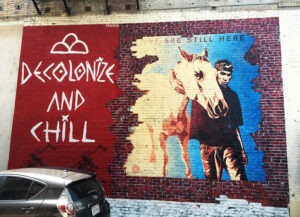Dakota Pipeline protesters hang “Divest #NoDAPL” sign from rafters at Vikings game https://t.co/VLFrbJVdl9 pic.twitter.com/1jwRMDBLlH
— The Hill (@thehill) January 1, 2017
Ticketholders at the last Minnesota Vikings game of the season were treated to two shows on Sunday—the game itself, and another staged by three protestors who rappelled down from the top of the U.S. Bank stadium to unfurl a banner which sported the U.S. Bank logo and read, “Divest #NoDAPL,” a reference to the Dakota Access Pipeline. The protesters were booked into and released from the Hennepin County jail, all within 24 hours. It is unclear to what extent they will be prosecuted.
Sign up for our free newsletters
Subscribe to NPQ's newsletters to have our top stories delivered directly to your inbox.
By signing up, you agree to our privacy policy and terms of use, and to receive messages from NPQ and our partners.
As we have mentioned before, civil disobedience often tries to do a number of things at one time: link an institution to a practice deemed by protestors to be unjust, interrupt day-to-day activities in an attempt to remind people that the comfortable status quo for some can be highly uncomfortable for others, and indicate that those involved are willing to make sacrifices and interrupt their own lives and those of others to call attention to and gain sympathy for the issues at play.
Yesterday, for instance, members of the NAACP sat down in Jeff Sessions’ office in Mobile, Alabama and vowed to stay either until the conservative Republican lawmaker withdraws his name from consideration as candidate for U.S. Attorney General or they are arrested. Sessions has suggested that the NAACP and the American Civil Liberties Union could be called “un-American” and has dubbed the Voting Rights Act of 1965 a “piece of intrusive legislation.”
“Senator Sessions has callously ignored the reality of voter suppression but zealously prosecuted innocent civil rights leaders on trumped-up charges of voter fraud,” said NAACP President and CEO Cornell William Brooks. “As an opponent of the vote, he can’t be trusted to be the chief law enforcement officer for voting rights.”
Police finally removed the NAACP protestors at 6 pm. Even as this action was going on, a letter signed by 1100 law school professors was on its way to the Senate Judiciary Committee, asking it to reject Sessions as nominee. This is another feature of civil disobedience: Very often, it’s one aspect of a larger coordinated campaign.
Many such protests are necessarily venue-sensitive—blocking highways or bridges or lunch counters, laying in front of bulldozers, or chaining oneself to a gate. It’s all about using the venue to help amplify a message in dramatic form. Often it involves some sort of trespass or blockade or symbol – and most recently those may be digital as well as physical.
Considering some of the president-elect’s many stated regressive positions on issues of civil and human rights, many expect acts of civil disobedience to increase during the Trump administration, starting with the inauguration. So this we hope you find this piece by Rick Cohen on the strategies, tactics and venues of civil disobedience useful to review. We’ll be tracking it from here.—Ruth McCambridge













